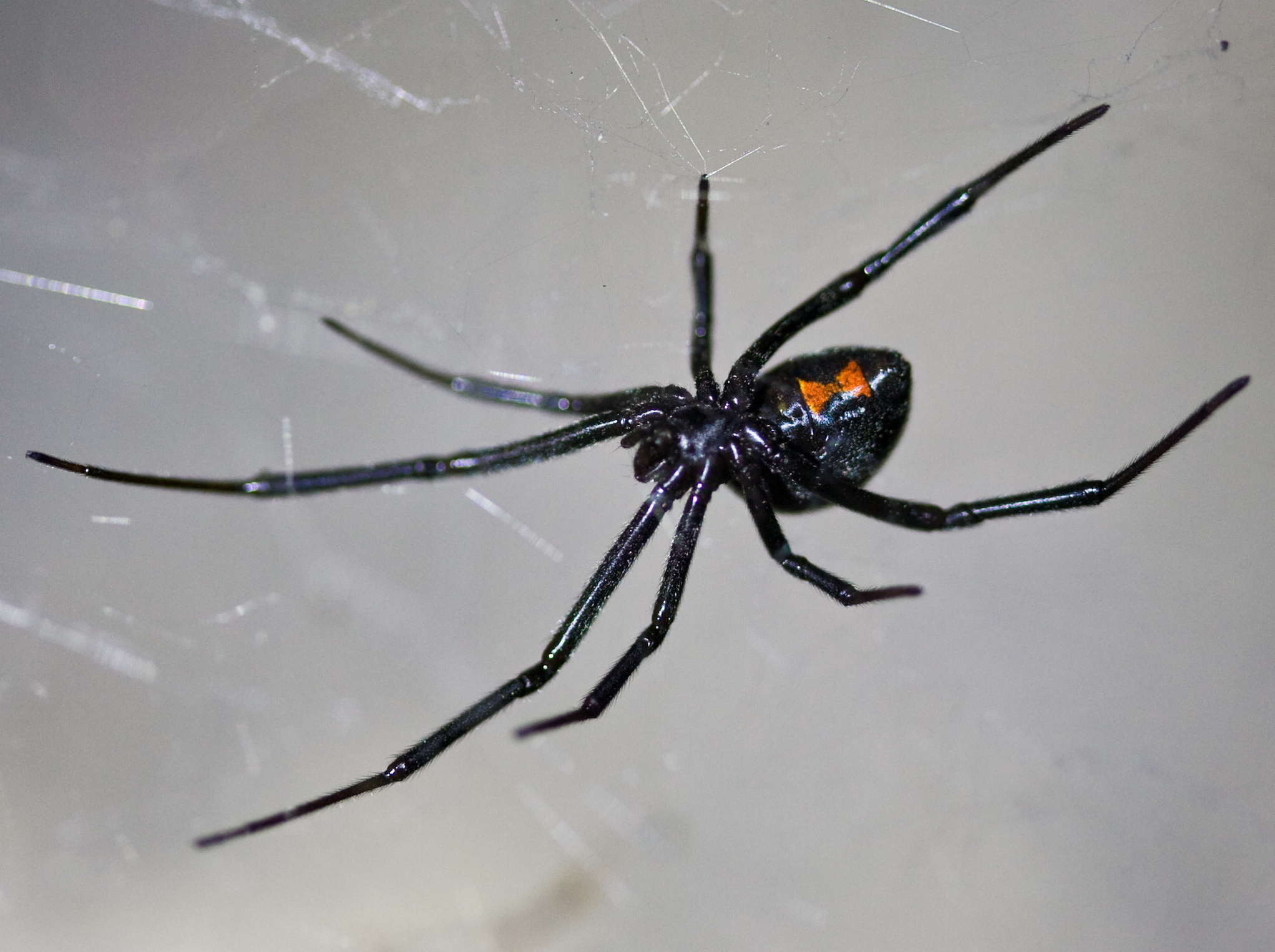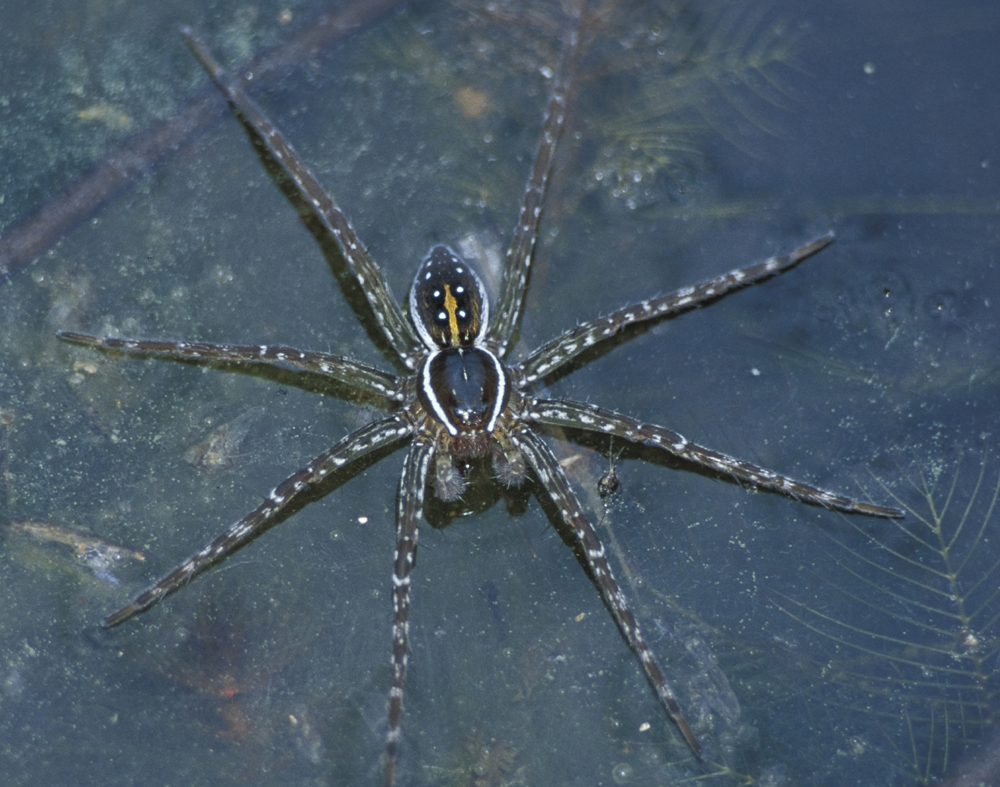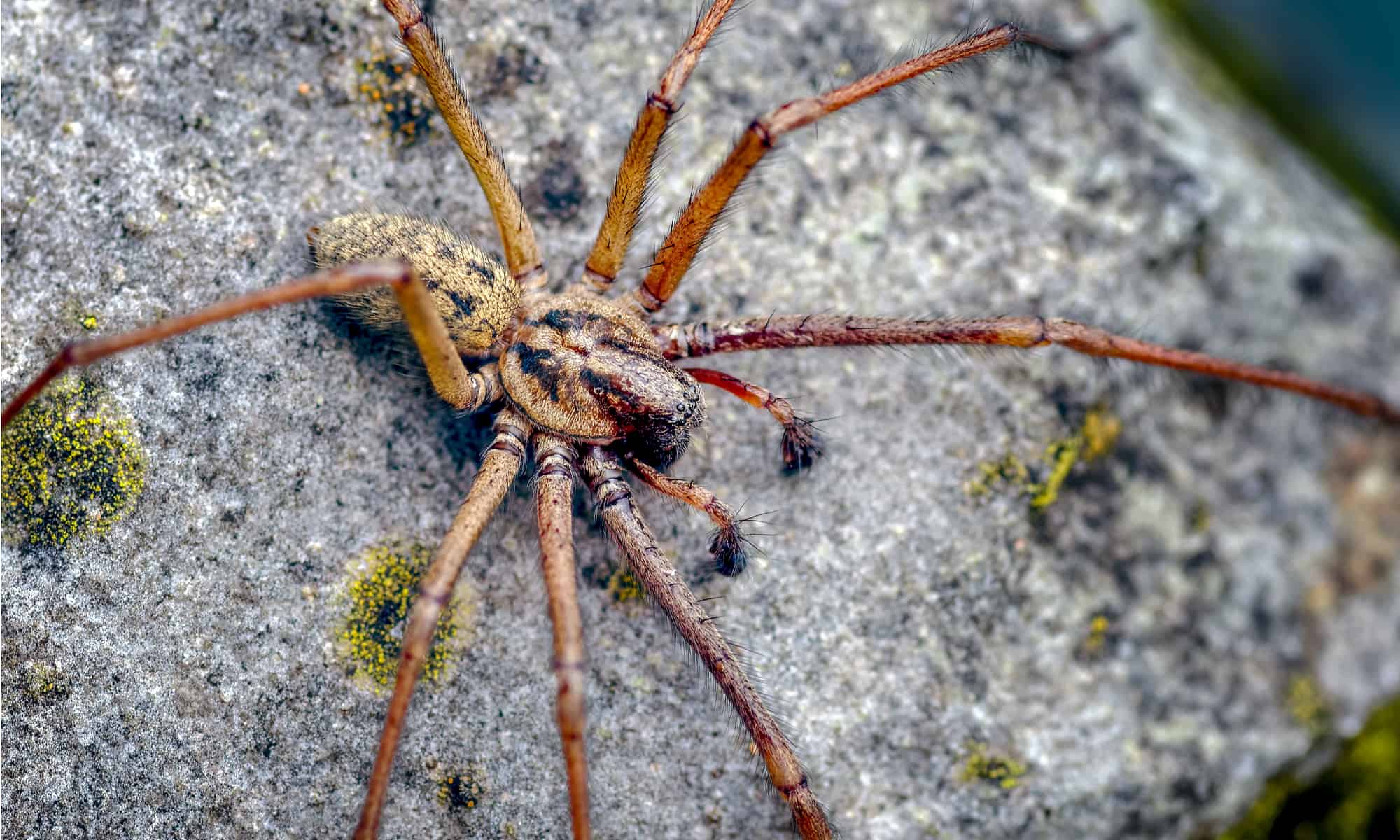Spiders are fascinating creatures that have been around for millions of years. They come in all shapes and sizes, from tiny jumping spiders to massive tarantulas.
In this article, we will explore the top 10 biggest spiders crawling around the United States. These spiders are sure to impress with their size and unique characteristics. Whether you are a spider enthusiast or simply curious about these arachnids, let’s delve into the world of the biggest spiders crawling around the United States and see how they measure up!
You are reading: The Top 10 Biggest Spiders Crawling Around The United States

The Top 10 Biggest Spiders Crawling Around The United States
Six-Spotted Fishing Spider (Dolomedes triton)

The Six-Spotted Fishing Spider (Dolomedes triton) is an arachnid from the nursery web spider family Pisauridae. This species is from the genus Dolomedes, or the fishing spiders.
Found in wetland habitats throughout North America, these spiders are usually seen scampering along the surface of ponds and other bodies of water. They are also referred to as dock spiders because they can sometimes be witnessed quickly vanishing through the cracks of boat docks. D. triton are capable of capturing fish up to five times their body size, and they use venom to immobilize and kill prey.
This species is diurnal and thus hunts during the day. It takes young SSFSs two winters to mature enough to perform their risky dance on the water. On average, the length of females is 17-26mm, and males are 9-13mm.
The length for females can sometimes exceed 30mm. Apparently, the common name “six-spotted fishing spider” comes from six distinct dark spots on this spider’s rarely seen sternum (the underside of the carapace) .
Giant House Spider (Eratigena atrica)

The Giant House Spider (Eratigena atrica) is a species of spider that belongs to the family Agelenidae. It is one of the largest spiders found in Central and Northern Europe and is known for its speed, running up to half a meter per second.
The giant house spider was previously placed in the genus Tegenaria but was moved to the new genus Eratigena in 2013. However, in 2018, the three separate species, E. atrica, E. duellica, and E. saeva, were restored.
The spider is brown, with a large hairy body, and can grow up to 0.73 inches long in the body with a leg span of around 1.8 inches for females, while males are a little smaller in the body at 0.47-0.59 inches long but with a leg span of 0.98-2.95 inches.
The giant house spider spins sheet-like cobwebs and is commonly found in dark corners of houses, particularly in autumn. They are seen around the house with their sheet-like cobwebs spread near warmer areas to avoid the cold. The species is rare and has a conservation status of common.
Carolina Wolf Spider (Hogna carolinensis)
The Carolina Wolf Spider (Hogna carolinensis) is the largest of the wolf spiders found in North America, measuring at 18-20 mm for males and 22-35 mm for females.
Here are some interesting facts about the Carolina Wolf Spider:
– The Carolina Wolf Spider is mottled brown with a dark underside, and males have orange coloration on their sides.
– They live in either self-made burrows or ones they find and hunt by ambushing prey from their burrows.
– Like all wolf spiders, H. carolinensis does not make a web to catch prey.
– The females are particularly known for carrying their egg sacs on their bodies during the incubation period.
– The Carolina Wolf Spider is found across North America and has made every part of the continent its home.
– The species is usually regarded as the largest of the wolf spiders found in North America.
– Hogna carolinensis is commonly known as the Carolina wolf spider, and historically, it was known as Lycosa carolinensis.
– The Carolina Wolf Spider is a carnivore and eats animals.
Read more : 4 Types Of Wasps In Florida Ranked By The Pain Of Their Sting
Overall, the Carolina Wolf Spider is a fascinating species that is known for its large size and unique characteristics.
Black Widow Spider (Latrodectus spp.)
The Black Widow Spider (Latrodectus spp.) is a venomous spider that belongs to the genus Latrodectus.
Here are some interesting facts about the Black Widow Spider:
– The Black Widow Spider is known for its distinctive black and red coloring, with the females being more recognizable than males.
– The species is native to North America and is found in all 48 contiguous states.
– The venom of the Black Widow Spider is neurotoxic and can cause pain, muscle rigidity, and other symptoms, but is rarely fatal to healthy humans.
– There are more than 30 different types of Black Widow Spiders worldwide, with five primary species residing in the United States.
– The species is often confused with other spiders, such as the false widow spiders.
– The Black Widow Spider is known for occasionally eating its mates after reproduction.
– The spider is commonly found in dark, dry places such as woodpiles, garages, and basements.
– The adult female Black Widow Spider is about 1/2 inch long, not including the legs, while the adult male is smaller.
– The species is responsible for most of the clinically significant envenomation among all species of spiders in the United States.
Overall, the Black Widow Spider is a fascinating but potentially dangerous species that is known for its distinctive coloring and venomous bite.
Brown Recluse Spider (Loxosceles reclusa)
The Brown Recluse Spider (Loxosceles reclusa) is a venomous spider that belongs to the family Sicariidae.
Here are some interesting facts about the Brown Recluse Spider:
– The Brown Recluse Spider is one of three spiders in North America with medically significant venom, the others being the Black Widow and the Chilean recluse.
– The species is usually light to medium brown, but they range in color from whitish to dark brown or blackish gray.
– Brown Recluse Spiders are usually between 6 and 20 millimeters (0.24 and 0.79 in), but may grow larger.
– The Brown Recluse Spider is rarely aggressive, and bites from the species are uncommon.
– The species is found mostly in the south, west, and midwest areas of the United States, and they are usually in dark areas such as under rocks, in the bark of dead trees, attics, basements, cupboards, drawers, boxes, bedsheets, or similar locations.
– The venom of the Brown Recluse Spider can cause necrotic lesions in humans, but bites are rare.
– Contrary to popular belief, there are no populations of the Brown Recluse Spider in California.
– The Brown Recluse Spider is part of the Loxosceles genus of spiders, which have violin-shaped markings on the top of their cephalothorax and may be informally referred to as fiddleback or violin spiders.
– The Brown Recluse Spider is frequently reported in Florida as a cause of necrotic lesions in humans.
Overall, the Brown Recluse Spider is a venomous species that is known for its distinctive violin-shaped markings and necrotic venom. While bites are rare, it is important to be cautious around this species and seek medical attention if bitten.
Desert Tarantula (Aphonopelma chalcodes)
The Desert Tarantula (Aphonopelma chalcodes) is a species of spider belonging to the family Theraphosidae.
Here are some interesting facts about the Desert Tarantula:
– The Desert Tarantula is also known as the Western Desert Tarantula, Arizona Blonde Tarantula, or Mexican Blonde Tarantula.
– The species has a limited distribution in the deserts of Arizona and adjacent parts of Mexico but can be very common within this range.
– The common name “blonde tarantula” refers to the carapace, which is densely covered in pale hairs, and contrasts strongly with the all-dark legs and abdomen.
– The Desert Tarantula is a terrestrial spider that is commonly seen during the summer rainy season in southwestern deserts.
– The female Desert Tarantula is usually a solid tan color, while males normally have black legs, a copper-colored carapace, and a reddish abdomen.
– The species is known for its “blonde” hairs and chill demeanor.
– The Desert Tarantula is a medium-sized tarantula, reaching a maximum size of about 6 inches.
– The species is an excellent eater and is known to be a perfect species to add to your collection whether you’re a beginner or more experienced.
– The Desert Tarantula is common throughout the Southwestern United States, especially Arizona, New Mexico, and Southern California.
Overall, the Desert Tarantula is a fascinating species that is known for its distinctive blonde hairs and chill demeanor. While they may seem intimidating, they are a great species to add to a collection and are commonly found in the southwestern United States.
California Trapdoor Spider (Bothriocyrtum californicum)
The California Trapdoor Spider (Bothriocyrtum californicum) is a species of spider that belongs to the family Halonoproctidae.
Here are some interesting facts about the California Trapdoor Spider:
– The California Trapdoor Spider constructs and lives in a silk-lined burrow, which is a vertical hollow tube up to about 3/4″ wide and 8″ deep.
– The top of the burrow is covered with a hinged trapdoor made of soil and silk, which the spider uses to ambush prey.
– The California Trapdoor Spider is native to Southern California and is commonly found in dry, south-facing, gently sloping hillsides or level terrain.
– The species is often confused with tarantulas, but they are smaller and have a shiny, hairless exoskeleton.
– The California Trapdoor Spider is a burrowing spider that is rarely seen above ground.
– The spider is known for its strength and is considered the strongest spider in the world according to Guinness World Records.
– The California Trapdoor Spider is not considered dangerous to humans, and bites are rare.
– The species is the most commonly encountered species of the trapdoor family.
– Both male and female California Trapdoor Spiders are similar in appearance, with females being slightly larger.
Overall, the California Trapdoor Spider is a fascinating species that is known for its burrowing behavior and unique trapdoor. While they may be mistaken for tarantulas, they are smaller and have a shiny, hairless exoskeleton.
Texas Brown Tarantula (Aphonopelma hentzi)
The Texas Brown Tarantula (Aphonopelma hentzi) is a species of tarantula that is commonly found in the Southern United States, including Texas, Oklahoma, and Missouri.
Here are some interesting facts about the Texas Brown Tarantula:
– The Texas Brown Tarantula is one of the most common species of tarantula living in the Southern United States today.
– The species can grow to leg spans in excess of 10 cm (4 in) and weigh more than 85 g (3 oz) as adults.
– The body of the Texas Brown Tarantula is dark brown, though shades may vary between individual tarantulas.
– The Texas Brown Tarantula is known for being very docile and long-lived, with females living over 30 years and males living between 8-12 years.
– The species is nocturnal and prefers dry rocky glades, where they spend their days in silk-lined burrows in abandoned rodent or reptile tunnels or in other natural cavities.
– Texas Brown Tarantulas are terrestrial species commonly found in grasslands.
– The species is the main preyed upon by the tarantula hawk, Pepsis grossa, in areas where the two species overlap.
– Bites from the Texas Brown Tarantula, as with all New World tarantulas, are generally not a serious harm to humans except in the case of an allergic reaction.
– The Texas Brown Tarantula is Missouri’s largest spider, and there are more than 50 species of tarantulas in North America, but this is apparently the only one native to Missouri.
Overall, the Texas Brown Tarantula is a fascinating species that is known for its large size, docile nature, and long lifespan. While they may seem intimidating, bites are generally not harmful to humans, and the species is commonly found in the Southern United States.
Goliath Birdeater (Theraphosa blondi)
Read more : 7 Types Of Flat Fish Ranked By Size
The Goliath Birdeater (Theraphosa blondi) is a species of tarantula that is native to the rainforests of South America, including Venezuela, Guyana, Suriname, Northern Brazil, and French Guiana.
Here are some interesting facts about the Goliath Birdeater:
– The Goliath Birdeater is the largest spider in the world by mass and body length, weighing up to six ounces and with a leg span of nearly a foot.
– Despite its name, the Goliath Birdeater rarely preys on birds, and its diet mainly consists of insects, worms, frogs, and rodents.
– The species is known for its docile nature and is often kept as a pet by tarantula enthusiasts.
– The Goliath Birdeater is nocturnal and emerges from its burrow at night to hunt for prey.
– The spider is terrestrial and lives in deep burrows in the ground, often in marshy or swampy regions.
– The Goliath Birdeater is an ambush predator and lies in wait for prey to cross its path, rather than hunting food down.
– The species is known for its hissing noise, which it creates by rubbing its hairs together, and it can also fling its hairs at attackers.
– The Goliath Birdeater is relatively harmless to humans, and bites are rare.
– Females can live up to 20 years, while males have a shorter lifespan of 3-6 years.
Overall, the Goliath Birdeater is a fascinating species that is known for its large size, docile nature, and unique characteristics. While they may seem intimidating, they are relatively harmless to humans and are often kept as pets by tarantula enthusiasts.
Brazilian Wandering Spider (Phoneutria spp.)
The Brazilian Wandering Spider (Phoneutria spp.) is a genus of spiders that includes nine species, all of which are nocturnal and can be found in Brazil, with some species also found throughout Central and South America.
Here are some interesting facts about the Brazilian Wandering Spider:
– The Brazilian Wandering Spider is also known as the armed spider or banana spider.
– The genus name Phoneutria means “murderess” in Greek, which is fitting given that it is one of the most venomous spiders on Earth.
– The species is known for its neurotoxic venom, which can be deadly to humans, especially children.
– The Brazilian Wandering Spider is the largest spider in South America and can grow up to 5 inches in length.
– The spider is known for its aggressive defense posture, in which it raises its front legs straight up into the air.
– The species is often found on banana leaves, which is why it is sometimes referred to as the banana spider.
– The Brazilian Wandering Spider is not commonly found in the United States, but it has been found in banana shipments from South America.
– The spider’s venom can cause symptoms such as salivation, irregular heartbeat, and prolonged painful erections (priapism) in men.
– The genus Phoneutria was started by Maximilian Perty in 1833, and the genus name is from the Greek φονεύτρια, meaning “murderess”.
Overall, the Brazilian Wandering Spider is a fascinating but potentially dangerous species that is known for its neurotoxic venom and aggressive defense posture. While they are not commonly found in the United States, it is important to be cautious around this species and seek medical attention if bitten.
FAQS
1. Are all spiders venomous?
Most spiders do possess venom glands, but not all spiders are venomous to humans. In fact, with a few exceptions, spider venoms are not harmful to humans or other mammals.
2. Which spiders in the United States are considered medically important?
Of the more than 3,700 species of spiders in the United States, only about a dozen are considered medically important. Those species fall into two groups, the brown spiders (Loxosceles spp.) and the widow spiders (Latrodectus spp.) .
3. Are black widow spider bites a significant health risk?
Black widow spider bites are a significant health risk for the very young, elderly, and those with high blood pressure and compromised immune system.
4. Are brown recluse spider bites a health concern?
Although brown recluse spider bites are not fatal, individual reactions to venom vary and may pose a significant health risk to some.
5. What is the most venomous spider in the world?
The Brazilian wandering spider is considered the world’s most venomous spider.
6. Are tarantulas dangerous to humans?
Most tarantulas are not dangerous to humans, although some species have venom that can cause discomfort or allergic reactions in some people.
7. How can I prevent spider bites?
To prevent spider bites, it is recommended to keep your home clean and free of clutter, wear long sleeves and pants when working outside, and shake out clothing and shoes before wearing them.
8. What should I do if I am bitten by a spider?
If you are bitten by a spider, it is recommended to clean the bite area with soap and water, apply a cool compress, and seek medical attention if you experience severe symptoms.
Source: https://petstutorial.com
Category: Animals










